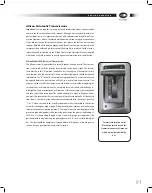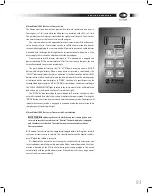
83
r o u t i n e
o p e r a t i o n
[CAUTION]
Wait until the “Wait to Start” light is no longer illuminated
before turning the ignition to the “Start” position. Do not crank the engine
continuously for more than 30 seconds. If the engine has not started in 30
seconds, allow the starter motor to cool for at least 2 minutes. Do not engage
the starter when the engine is running. Do not attempt to start the engine
under load.
4. While the engine is cranking, the instrument panel lights will go off.
After
the engine is running, the gauges will cycle through their startup sequence.
After the startup sequence, if any indicator lights remain on, take appropri-
ate action according to the indicated condition.
[CAUTION]
The oil pressure should rise within 15 seconds after the engine
starts. Do not increase engine speed until the oil pressure gauge indicates nor-
mal. If oil pressure is not indicated on the gauge in 15 seconds, do not operate
the bus. Stop the engine and refer to qualified service personnel.
5. Release the key switch and allow it to return to the “ON” (or run) position
immediately after the engine starts. After the engine starts, ensure that the
transmission is still in the neutral position. Once a normal engine oil pressure
and air pressure are established, the vehicle may be operated at a light load
and speed.
6. After the engine has started, the air inlet heater may continue to run in a
“continuous” mode or intermittently. The air inlet heater will automatically
turn off when the sum of the engine coolant temperature and the air inlet
temperature exceeds 127º F (35º C).
7. If the engine is operated at a light load and low speed, it will reach normal
operating temperature more quickly than if it idles at no load. When idling in
cold weather, increase the engine idle speed to a maximum of 1200 revolu-
tions per minute (RPM); this is the “HIGH IDLE” function. Do not exceed the
no-load recommended RPM during the warm up process. Limit unnecessary
idle time to 10 minutes.
High Idle Function
The high idle control positions the throttle at high idle. This allows the engine to
warm up faster than at the normal low idle position. High idle is limited to 1000 to
1200 revolutions per minute (RPM). High idle can be activated by a switch in the
driver’s area. With the transmission in the neutral position and the park brake set,
move the toggle switch to the “HIGH IDLE” position to maintain a constant engine
RPM above the normal idle speed.
[CAUTION]
Do not move the toggle switch to the high idle position unless
the transmission is in Neutral and the park brake is engaged.
High Idle Switch
Summary of Contents for VISION 2011
Page 1: ...10013333 2011 BBCV D R I V E R S H A N D B O O K 10013333 BBCV BLUE BIRD VISION 2011 ...
Page 2: ......
Page 3: ...10013333 Revision B ...
Page 8: ...VISION D R I V E R S H A N D B O O K 6 ...
Page 26: ...VISION D R I V E R S H A N D B O O K 24 ...
Page 70: ...VISION D R I V E R S H A N D B O O K 68 ...
Page 137: ...135 Notes n o t e s ...
Page 138: ...VISION D R I V E R S H A N D B O O K 136 Notes ...
Page 139: ......
Page 140: ...10013333 2011 BBCV D R I V E R S H A N D B O O K 10013333 BBCV BLUE BIRD VISION 2011 ...






























